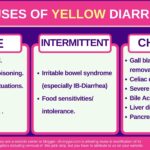9 Common Stool Changes with Pancreatitis (With color illustrations).
Our content is not intended nor recommended as a substitute for medical advice by your doctor. Use for informational purposes only.
The inflammation of the pancreas (whether acute or chronic) is often manifested by severe upper stomach pain. However, there is no detailed data about the stool and bowel habit changes with pancreatitis.
So, today, we will explain possible stool changes (color and consistency) in acute and chronic pancreatitis with picture illustrations.
However, no stool changes are characteristic of acute or chronic pancreatitis. Therefore, as gastroenterologists, we don’t depend on stool changes to diagnose acute or chronic pancreatitis.
A. Stool changes in acute pancreatitis:
1 . Yellow diarrhea.
Diarrhea is uncommon with acute pancreatitis. However, it can occur due to various causes and may result in changes in the stool color.
The causes of diarrhea with acute pancreatitis:
Your pancreas produces digestive enzymes that help you handle food. However, these digestive enzymes in acute pancreatitis may not reach the intestine (especially in cases with obstructed pancreatic ducts).
As a result, patients with acute pancreatitis may suffer from diarrhea because of the inability of their digestive system to handle food.
Also, patients with acute pancreatitis may develop diarrhea due to the overgrows of harmful bacteria (particularly in patients who don’t eat for days. Small intestinal bacteria overgrowth (SIBO) occurs within three days of the onset of acute pancreatitis leading to diarrhea (reference).
Other causes include:
- Antibiotic-associated diarrhea (patients with acute pancreatitis typically receive antibiotics to prevent complications).
- Intolerance to formula feeding during acute pancreatitis: patients with acute pancreatitis often receive a special formula feeding through a nasojejunal tube.
- Infection (gastroenteritis) during the attack of pancreatitis.
The causes of the yellow color:
Diarrhea from acute pancreatitis is often yellowish due to:
- Speeding up the gut contents allows no time for the stool to turn brown.
- More fat in the stool.
Is yellow diarrhea a common or sure sign of pancreatitis?
Diarrhea is not common with acute pancreatitis. Unlike chronic pancreatitis, diarrhea only affects people who have an infection, SIBO, or patients with complete pancreatic duct obstruction.
So, it is not a common nor a diagnostic sign of pancreatitis. But it can occur.
2. Hard stool (constipation).
Constipation (hard stools) is more common with acute pancreatitis than diarrhea. Patients with acute pancreatitis suffer from constipation due to a variety of causes. Also, some causes of acute pancreatitis are constipating in nature (such as hypercalcemia and cystic fibrosis).
Causes of constipation (hard stools) with acute pancreatitis:
- Pain medications (opioid analgesics) are the most commonly used medications to control pancreatic pain. Unfortunately, up to 90% of patients receiving opioids experience hard stool or constipation.
- Hypercalcemia-induced pancreatitis: high blood calcium (often due to benign parathyroid tumors) increases the risk of constipation and acute pancreatitis.
- Severe dehydration.
- Bowel obstruction.
- Paralytic ileus (the muscles of the small intestine cease to move properly, often due to severe pain and electrolyte disturbances).
- Cystic fibrosis-induced pancreatitis.
In patients with constipation and acute pancreatitis, the stool is often hard, difficult to pass, and the patients are unable to strain properly (to avoid pain).
Opioid-induced constipation can be treated by laxatives, good hydration, and decreasing the dose of analgesics.
3. Blackish stool (melena).
Bleeding inside the digestive tract can occur with acute pancreatitis. In addition, patients with acute pancreatitis are at higher risk of stomach ulcers, duodenal ulcers, intestinal perforation, and intestinal infarctions.
All the above conditions cause bleeding in the gut tract with consequent black stools in patients with acute pancreatitis.
The bleeding inside the stomach, duodenum, or small intestine often manifests by one or more of:
- Black tarry stools (processed blood turns black while passing through the digestive system).
- Vomiting of blood (hematemesis).
- Symptoms of severe anemia (severe pallor, shortness of breath, headache, dizziness, and fainting).
- Symptoms of low blood volume (low blood pressure): dizziness, rapid heartbeats, headache, and maybe coma.
The blackish stool is often loose and sticky, which has a characteristic offensive odor (rotten meat odor).
Blackish stool with acute pancreatitis is an emergency, and you should report that immediately to your doctor or nurse.
Treatment:
Your doctor may need to perform an endoscopy to spot and control the source of bleeding. In addition, blood transfusion is often needed (based on the severity of bleeding and the degree of resulting anemia).
Also, surgery may be needed in severe cases (with perforation and intestinal infarction).
4. Pale (white) stool.
The pancreatic ducts join the common bile duct, and both share a common opening pouring their secretions (biliary and pancreatic) into the duodenum.
The location where your bile and pancreatic duct join and empty into the duodenum is called (the ampulla of Vater).
40-70% of the cases of acute pancreatitis are due to gallstones obstructing the pancreatic duct or the ampulla of Vater.
Due to the obstruction of the ampulla of Vater, both bile and pancreatic secretions become unable to reach the intestine.
As a result, the stool becomes very pale (clay or whitish stool) due to the absence of bile from the stool.
Patients with gallstones, pancreatitis, and biliary obstruction often have a tetrad of:
- Extreme pancreatic and biliary pain.
- Clay stool.
- Jaundice.
- Dark urine.
Patients with biliary and pancreatic duct obstruction may need an emergency endoscopy (endoscopic retrograde cholangiopancreatography) to relieve the obstruction.
B. Stool changes in chronic pancreatitis (steatorrhea):
Not all patients with chronic pancreatitis have abnormal stool changes. Steatorrhea (fatty diarrhea) doesn’t occur in chronic pancreatitis unless >90% of the pancreatic tissue becomes destructed (reference).
So, stool changes with chronic pancreatitis may take several years to occur. And most patients with mild to moderate chronic pancreatitis may have entirely normal stools.
1 . Grey or pale yellow stool.
The maldigestion of fat leads to its malabsorption. Consequently, fat passes into the stool giving it its characteristic yellowish or grey color.
The stool is greyish and bulky in severe cases with an offensive odor. The condition is more exaggerated when you eat excess fat.
2. Oily stools.
This is one of the most common stool changes with chronic pancreatitis. The fat in the stool makes the stool greasy or oily. Patients with chronic pancreatitis may also notice oil drops on the toilet water’s surface.
3. Floating stools.
The high-fat content of the stool in patients with chronic pancreatitis prevents the stool from being soaked in water.
As a result, your stool maintains its low density and floats on the toilet water.
However, floating poop is not specific to chronic pancreatitis, and it can occur with other conditions such as:
- Celiac disease.
- Lactose intolerance.
- Inflammatory bowel disease (Crohn’s disease and ulcerative colitis).
- Excess eating of gas-producing foods.
- Irritable bowel syndrome.
4. Watery stools (diarrhea).
Diarrhea (watery stool) in chronic pancreatitis is less common and often occurs in late (advanced) cases of chronic pancreatitis (reference).
Due to malabsorption, the stool also becomes bulkier.
5. Abnormally offensive stool.
Due to the malabsorption associated with chronic pancreatitis (Exocrine pancreatic insufficiency), food stays
As a result, bacteria break down the unabsorbed food and nutrients, producing foul-smelling gas.
- Evidence-based
- Written by a doctor.







